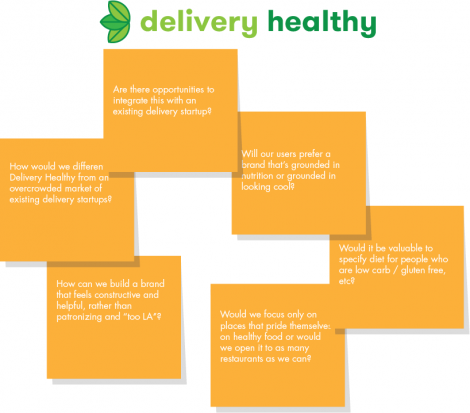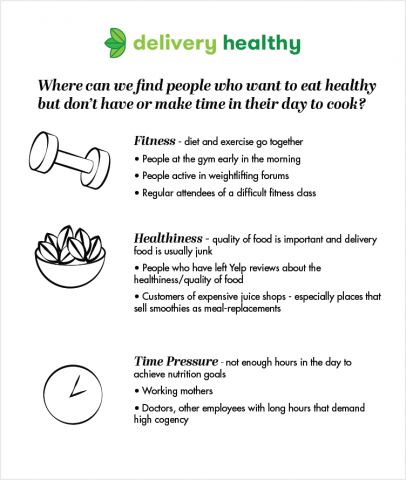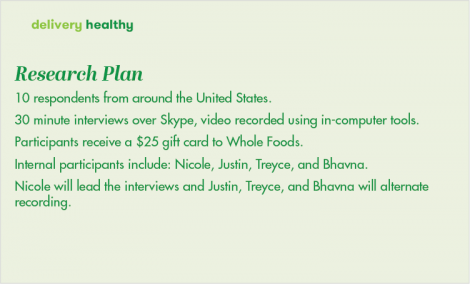The Carbon Five Guide to User Research: Starting Your Research Project
So, you’ve read the introduction to the Carbon Five Guide to User Research and you’re ready to get started. Welcome!
During this step we’ll be working through what we’re hoping to find, who we’re hoping to talk to, and what we’re hoping to ask. If you’re trying to convince someone else in your company to invest in a research project identifying the basic assumptions and outcomes like this is a great place to start.
We’ll be using the hypothetical company Delivery Healthy. Delivery Healthy is a startup that serves people who are trying to eat healthy while still ordering a lot of take-out, because they say you should write what you know.
Ready? Let’s go!
Step 1: Define your unknowns
If you have a defined goal for your product, talk through everything that feels undefined that needs to happen in order for your product to be successful. As you’re grappling with things that could go wrong, have someone on hand to translate fears into questions that can be answered objectively. “What if no one uses it?” becomes “What will make this compelling to the users we’re trying to target?” This will help your team understand the range of problems you’re trying to solve.
If your product is still fuzzy, try writing up a Lean Canvas or similar plan designed to get specific about your business plan.

Step 2: Proto Personas
The goal of building proto personas is to take an educated guess about who your end users are, what they’ll need, and how you’ll might reach them.
If you don’t have a clear picture of who you’re going after, that’s okay. In fact, not thinking in strict demographics will help you recruit a wider range of potential users, which will help you identify audiences that are likely to be excited about your product and likely to help it grow. Brainstorm activities your product supports and problems your product might be able to solve then brainstorm people who might enjoy those activities or share those problems.
Here are a few sample questions for your proto personas:
- What are the key aspects of this user’s life situation that are relevant to our design inquiry?
- What is his/her technical ability, familiarity with technology and frequency of use?
- What does this user want to achieve using your product?
- Why is achieving these goals difficult today? How do they accomplish them anyway?
As you think through proto personas, capture them on a whiteboard. Once you’ve got a list of potential users down, discuss which of these audiences seem easiest to recruit, which constitute a large target audience, and finally, which are most likely to pay for and use your service. Overlap between those sets is a great place to focus your research. Have the team dot vote personas which seem promising.
For this product, we’re going to focus on people who are active at the gym: they’re a large target market, easy to recruit, and have already invested a lot in their health.

Step 3: Research Statement
Now that you know what questions you’d like to ask and who you’d like to ask them to, it’s time to gather up those threads into a statement that defines the scope of your inquiry. A good research statement defines a strict scope of work. It should be the big question that answers the smaller questions you’ve generated.

Here’s an example of a research statement that doesn’t work:
We will interview millenials to determine whether or not they would use a delivery service offering them healthy food.
What’s wrong with this statement? The respondents (“millenials”) are defined by demographic, not specific attributes, and the inquiry (“whether or not they would use a delivery service offering them healthy food”) can be answered with a simple yes or no, rather than illuminating the life circumstances that would make the service compelling.
We could rewrite the above statement as:
We will interview young professionals with 50+ hour work weeks to determine how they define and meet nutritional goals.
Here, the respondents (“young professionals with 50+ hour work weeks”) share a need: to incorporate eating into an already full schedule with little time for food prep, and the inquiry (“determine how they feed themselves on tight schedules”) opens the door for more questions about their lifestyle.
Step 4: Plan
How many people are you going to talk to?
Between 5 and 10 is a good number to target. If you’ve identified multiple personas you want to learn more about, set a goal of recruiting 5-7 of each.
How long will the interviews be?
Interviews usually run between 15-45 minutes. The time you allocate depends on the length of your script. Give yourself a little more time than you think you’ll need in case other questions come up. You can always change it later!
What incentives will you provide?
A good rule of thumb is to pay roughly the hourly wage of your respondents—a doctor and a teenager with a summer job will need different amounts for an interview to be worth their time. We generally give out gift cards or cash, depending on the length of the interview and the interests of the respondent. We make sure to have them on hand and ready to give out, even (especially) if the interview goes poorly and we want to end early.
What kind of recording equipment will you use?
Recording interviews (in addition to written notes from participants) is important in later steps of the process and useful if you need to convince stakeholders that yes, your users really did say that. A recording can be as simple as an audio file from your phone or can include video of the participant and screen recording. Talk to your team about how much data you need to capture.
(Note: If you’re going to be recording audio or video, your participant will need to sign a waiver indicating they know they’re being recorded. Here’s a sample form from usability.gov)
Who from your team will participate?
Identify who on your team will lead the interviews (it’s best to have one person lead all the interviews so they stay consistent) and who will participate. Ideally, your entire team will show up to take notes for one or more interview—it’s a great way of getting the developers who have to build the product to better understand the audience they’re building for. We try and rotate a new team member into each interview session until the whole team has seen at least one. We find that once someone participates in one session, they are more likely to trust the insights from the others that they don’t necessarily attend in person.

Step 5 – Write the Interview Script
Once you’ve defined the goal of your research, determined which users to start talking to, and discussed how you’ll capture the knowledge in a research plan, it’s time to figure out what you want to say! When you’re writing an interview script, here are a few things to keep in mind:
- Be concrete. Ask them about specific moments, rather than generalities. You’ll learn more accurate and specific information by asking “When was the last time you had this problem and how did you solve it?” than you will from “How do your normally solve this problem?”
- Ask them about them, not about your product. You already know about your product. You’re trying to find out where it fits in their lives. (Have your read the milkshake story?)
- Cover things that don’t work about existing ways
- Avoid questions that can be answered with yes or no. A good interview question leaves room for elaboration
- Check for leading questions. If you lead a user to an answer, they’ll likely tell you what you were hoping to hear. Remember, user research isn’t about confirming that your idea is the right one, it’s about hearing individual experiences that might make it even better
- Make sure to leave room for open questions at the end and make sure there’s time at the beginning to set up and get comfortable

These questions will give us a sense of what our user is trying to achieve, what obstacles they face, and what they think of existing competitors. They also should flow together so the interview feels like a conversation, but you’ll hear about that more later. Coming up next – Recruiting and Scheduling.
If this all feels a little overwhelming, don’t despair! It gets easier with practice. But if you’re looking for a little more practice while you learn, Carbon Five offers a User Research Sprint that will teach you these skills hands-on and help you apply them to your product.